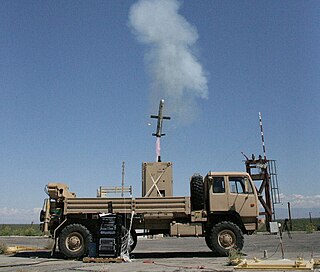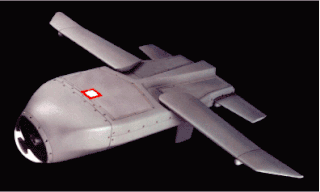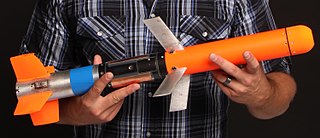Related Research Articles

A directed-energy weapon (DEW) is a ranged weapon that damages its target with highly focused energy without a solid projectile, including lasers, microwaves, particle beams, and sound beams. Potential applications of this technology include weapons that target personnel, missiles, vehicles, and optical devices. In the United States, the Pentagon, DARPA, the Air Force Research Laboratory, United States Army Armament Research Development and Engineering Center, and the Naval Research Laboratory are researching directed-energy weapons to counter ballistic missiles, hypersonic cruise missiles, and hypersonic glide vehicles. These systems of missile defense are expected to come online no sooner than the mid to late-2020s.

The IAI Harpy is a loitering munition missile produced by Israel Aerospace Industries. The Harpy is designed to attack radar systems and is optimised for the suppression of enemy air defences (SEAD) role. It carries a high explosive warhead. The Harpy has been sold to several foreign nations, including South Korea, Turkey and China.

The ADM-160 MALD is a decoy missile developed by the United States.

UAVs include both autonomous drones and remotely piloted vehicles (RPVs). A UAV is capable of controlled, sustained level flight and is powered by a jet, reciprocating, or electric engine. In the twenty first century technology reached a point of sophistication that the UAV is now being given a greatly expanded role in many areas of aviation.

The Non-Line of Sight Launch System (NLOS-LS) was a self-contained missile launcher system that was under development by NETFIRES LLC, a partnership between Lockheed Martin and Raytheon. Each Container Launch Unit (CLU) holds 15 missiles, and a self-locating networked communications system. CLUs can be linked for coordinated launching, with the missiles fired and controlled remotely via autonomous vertical launch. The weapon is roughly 2 metres tall.

The Low Cost Autonomous Attack System (LOCAAS) was a loitering attack munition developed for the United States Air Force (USAF). In 1998 the USAF and U.S. Army Lockheed Martin began to examine the feasibility of a small, affordable cruise missile weapon for use against armoured and unarmoured vehicles, materiel and personnel, and if so develop a demonstration program. The program cost approximately $150,000,000; the cost per unit was calculated to be $30,000 based on a production of 12,000 units before cancellation.

The AGM-176 Griffin is a lightweight, precision-guided munition developed by Raytheon. It can be launched from the ground or air as a rocket-powered missile or dropped from the air as a guided bomb. It carries a relatively small warhead, and was designed to be a precision low-collateral damage weapon for irregular warfare. It has been used in combat by the United States military during the War in Afghanistan.

UMTAS or Mizrak-U(Uzun Menzilli Tanksavar Sistemi) is a modern long range air-to-surface anti-tank guided missile developed by Turkish armor and missile manufacturer Roketsan.

The Delilah missile is a cruise missile or loitering munition developed in Israel by Israel Military Industries (IMI). It is designed to target moving and re-locatable targets with a circular error probable (CEP) of 1 metre. Unlike a typical cruise missile, which is locked onto a pre-programmed target prior to launch, the Delilah missile's unique feature, as claimed by the manufacturer, is being able to loiter and surveil an area before a remote weapon systems officer, usually from the launching fighter aircraft, identifies the specific target of the attack.

The IAI Harop is a loitering munition developed by the MBT division of Israel Aerospace Industries. Loitering munitions are designed to loiter above the battlefield and attack targets by crashing into them and exploding.

A precision-guided munition is a guided munition intended to precisely hit a specific target, to minimize collateral damage and increase lethality against intended targets. During the First Gulf War guided munitions accounted for only 9% of weapons fired, but accounted for 75% of all successful hits. Despite guided weapons generally being used on more difficult targets, they were still 35 times more likely to destroy their targets per weapon dropped.
Quick Kill is an active protection system (APS) designed to destroy incoming anti-tank missiles, rockets, and grenades. The Quick Kill system is designed and produced by Raytheon for the U.S. Army. The Quick Kill system was part of the United States Army's Future Combat Systems.

The AeroVironment Switchblade is a miniature loitering munition designed by AeroVironment and used by several branches of the United States military. Small enough to fit in a backpack, the Switchblade launches from a tube, flies to the target area, and crashes into its target while detonating its explosive warhead. The name switchblade comes from the way the spring-loaded wings are folded up inside a tube and flip out once released.

The Spike, also called the Forward Firing Miniature Munition (F2M2), is a small missile developed by the USA Naval Air Warfare Center Weapons Division (NAWCWD), NAVAIR's Weapons Division.
The Pike is a precision-guided mini-missile or grenade munition designed by Raytheon. It is a 40 mm guided munition that can be fired from the barrel of a Heckler & Koch M320 Grenade Launcher Module and Enhanced Grenade Launching Module (EGLM) like a standard 40mm grenade, but is powered by a rocket motor to propel it 2,000 m to give infantrymen improved extended-range precision capabilities. The weapon uses a digital, semi-active laser seeker to guide itself to within five meters of the target; it can operate in a two-man shooter/spotter team or by the grenadier alone lazing after firing, as it can fly for 15 seconds before homing in. When fired, Pike has a small propellant to "kick" it 2.5–3 m (8.2–9.8 ft) out of the tube before the nearly smokeless motor ignites, and range is dependent on firing angle. The munition is effective against fixed and slow-moving mid-range targets, using a 6⁄10 lb blast fragmentation warhead with a 10-meter lethality radius. Raytheon developed the weapon for three years in collaboration with Nammo Talley, which developed the warhead and propulsion system. The Pike is intended to be more accurate with a longer range than rocket propelled grenades (RPGs) and standard rifle grenades, while being far lighter and more cost-effective than current infantry guided weapons like the $78,000 each FGM-148 Javelin. Further improvements could include different fuses, multiple-round simultaneous programming and targeting with data-link capabilities, and platform integration onto small boats, vehicles, and small unmanned aerial vehicles (UAVs). Pike weighs 1.7 lb (0.77 kg) and is 16.8 in (43 cm) long, too long to fit in the breech of the M203 grenade launcher. At AUSA 2015, Raytheon revealed they had performed two successful test firings of the Pike.
A loitering munition is a kind of aerial weapon with a built-in munition (warhead), which can loiter around the target area until a target is located; it then attacks the target by crashing into it. Loitering munitions enable faster reaction times against hidden targets that emerge for short periods without placing high-value platforms near the target area, and also allow more selective targeting as the attack can be changed midflight or aborted.

Cardinal is a family of small unmanned aerial vehicles made by the National Chung-Shan Institute of Science and Technology (NCSIST).

The HAL Combat Air Teaming System (CATS) is an Indian unmanned and manned combat aircraft air teaming system being developed by Hindustan Aeronautics Limited (HAL). The system will consist of a manned fighter aircraft acting as "mothership" of the system and a set of swarming UAVs and UCAVs governed by the mothership aircraft. A twin-seated HAL Tejas is likely to be the mothership aircraft. Various other sub components of the system are currently under development and will be jointly produced by HAL, National Aerospace Laboratories (NAL), Defence Research and Development Organisation (DRDO) and Newspace Research & Technologies.

UVision Air Ltd. is an Israeli defense technology company established in 2011. It engaged in the development, manufacturing and sales of advance missiles and loitering munition systems for land, air, and naval military forces. The company’s products, called HERO, are designed for targeted attacks against a variety of threats at various ranges.

The ZALA Lancet is an unmanned aerial vehicle (UAV) and loitering munition developed by the Russian company ZALA Aero Group for the Russian Armed Forces. It was first unveiled in June 2019 at the ARMY-2019 military expo in Moscow. It is a further development of the ZALA KYB-UAV loitering munition.
References
- ↑ "Army develops mini missile system components". UPI. Retrieved November 22, 2021.
- ↑ "Army develops mini missile system components". Space Daily. Retrieved November 22, 2021.
- ↑ "Lethal Miniature Aerial Munition System (LMAMS)". Defense Media Network. Retrieved November 22, 2021.
- ↑ "Loitering, lethal airborne system for U.S. Army on way". UPI. Retrieved November 22, 2021.
- ↑ Lethal miniature aerial munition system army.mil [ dead link ]
- ↑ "Army develops critical components for Lethal Miniature Aerial Missile System | Article | The United States Army".
- ↑ "AMRDEC develops critical components for Lethal Miniature Aerial Missile System — Medium". Archived from the original on August 20, 2016.